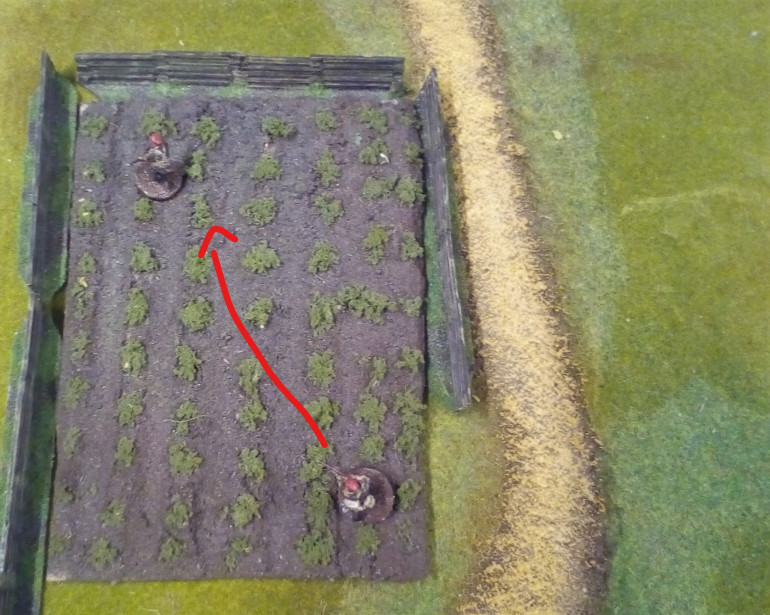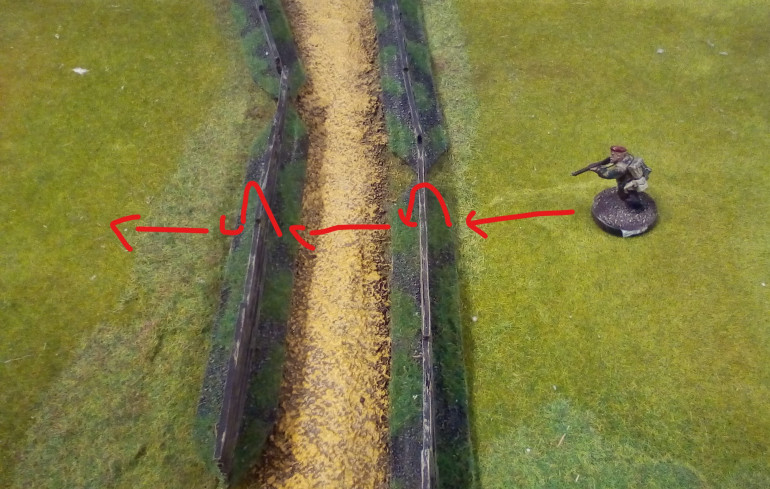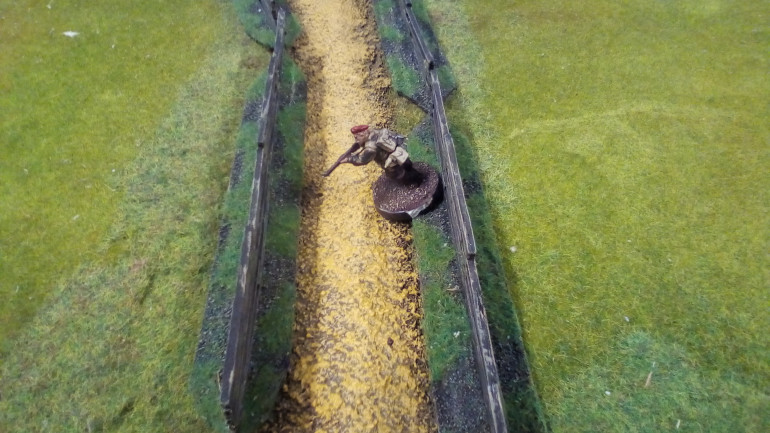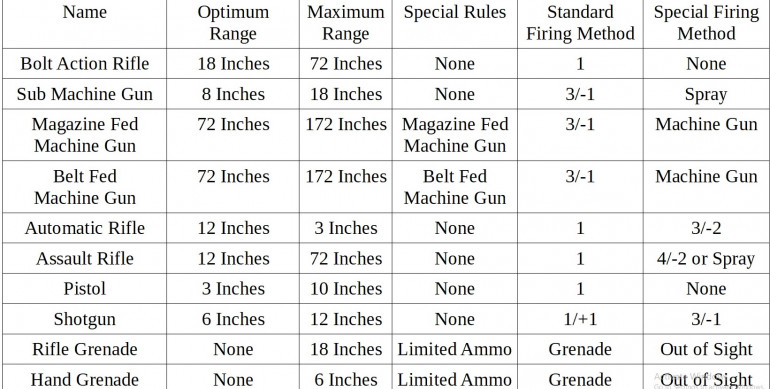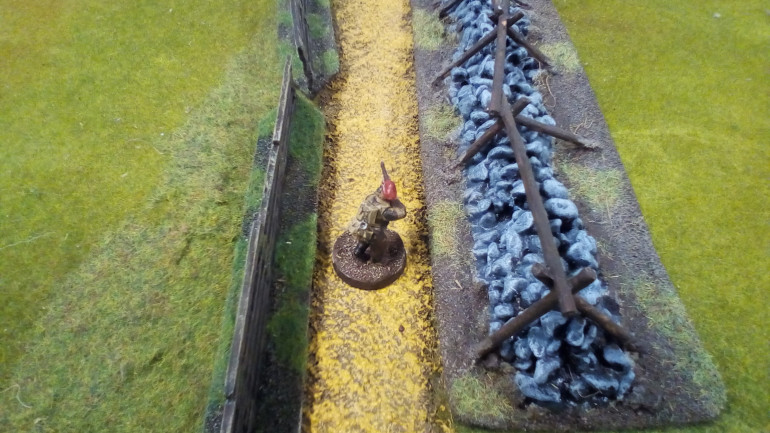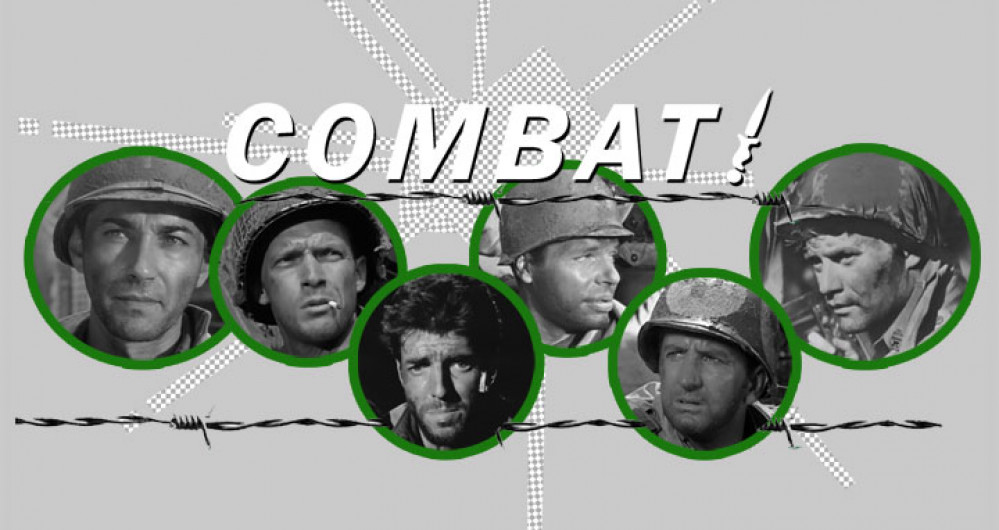
Combat Patrol! My Go at WWII Squad Level Wargaming Rules
Recommendations: 38
About the Project
Many Years ago I went on a Combat! Binge watching the TV show from the 60's with Vic Morrow and Rick Jason. At the time I was very bored and had a lot of spare time so I decided to have a go at writing up a way to wargame at the small scale they showed on the screen.
Related Genre: Historical
This Project is Active
Move! Move! Move!
Moving in Combat!
Something that drives me utterly insane about tabletop games is minis not being able to do very basic things that even I (someone who is far from in military shape) can do. I can run and jump over fences so why can’t my guys?
Well in Coimbat! they can it’s just risky.
As a general Rule crossing any kind of Fence like obstacle consumes 1 Inch of Movement to cross.
Difficult Terrain like a ploughed field count as double when moving through them. One Inch of Movement in a Field counts as Two Inches in Open Ground.
However this is a Squad level game where seconds count.
Soldier’s can run through difficult terrain and can run over obstacles they just run the risk of slipping or tripping.
When running across Difficult Terrain the solider can “Gamble” and declare that he will move X amount of Inches as if the terrain was open. If the soldier does this choose the value and roll a D10. If the result is higher than the chosen number then nothing happens and the move is completed as normal.
If the roll is failed roll another D10. Move the soldier this many inches then halt them and they become pinned. If a 10 is rolled the opponent decides this number.
If a soldier wants to vault over a fence while making a Combat Move then they just subtract 1 Inch from their movement for each obstacle they vault.
If a soldier wants to vault over a fence while making a run move first declare a start and end point and mark this in some way. If you want to be quick simply count the number of fences and roll a D10. If the result is lower than or equal to this number then the soldier has tripped and is pinned after vaulting a fence. The fence that the soldier tripped over is determined by the dice rolled.
For example if you wanted to cross two fences and roll a One then you cross the first fence and trip but if you rolled a Two then you will be tripped after crossing the second fence.
Designers Note: It’s a bit more complicated but a bit more thematic if you instead of just failing on a low roll you fail on a different number.
So if your Soldier is Two Inches from a fence he wished to vault (One Inch) then travel Three Inches before crossing another fence (One Inch) before moving another Two inches.
So instead of failing on a 1-2 the soldier would trip on a 3 or 7 since it takes Three inches of movement to cross the first fence and Seven to cross the second.
just for a bit of flavour but by no means a rule.
Close Combat
This should be very rare. When the other guy has a Semi Automatic or an SMG it’s generally not a good idea to charge them but it can happen and so there are rules for it.
To initiate close combat make a combat move into base contact with the enemy. They can choose to do one of Two things.
1. Fire
or
2. Retreat
The target Soldier can choose to Fire in which case they make a Standard Firing Method Attack with an additional -2 to Hit.
If they choose to retreat then make a Combat move that must be more than Six Inches from the starting point of the enemies charge move.
If the enemy makes it into base contact then both players roll a single D10 and consult the chart below.
If neither person is hit roll again. If nothing happens again, leave the soldiers in base contact and go on with the turn, rolling once at the end of each of any soldiers activation.
Fighting in Combat!
To shoot simply choose a weapon, check the range, declare the firing method, apply modifiers, roll to hit then either roll for damage or take a Reaction Test.
As an example we will look at a US Paratrooper and an Inexperienced German both armed with their standard Rifles.
To resolve one Soldier firing at another we must first decide which weapon the firing soldier is using.
The US Paratrooper is armed with an M1 Garand and so that is the weapon which will be used.
Next the Range is checked, it is established that the Paratrooper is 10 Inches from the German and is therefore in “Optimum Range”.
The US Player then decides if they will fire the weapon in the “Standard Firing Method” or the “Special Firing Method”. Each Weapon will have this clearly listed.
The Paratrooper decides to just use the Standard Firing Method and fires a single shot at the German.
Next we look at any potential modifiers that could influence the shot. The German Soldier is behind a wooden fence that counts as light cover which will subtract 1 from the paratroopers roll to hit.
Next we look at the US Paratrooper Profile and see that the Accuracy rating is 4+ from which we subtract the light cover and we see the final roll needed to hit the enemy is a 5+.
The Paratrooper then rolls a D10.
The Paratrooper Rolls a 5 and so does hit the German Soldier.
Shooting – Special
Many Weapons have a “Special Firing Method” which is clearly listed. When shooting (other than as a snap fire) a model may choose to use this Method rather than the “Standard Firing Method”. This will be looked at further in the Weapons Section.
Casualty Chart
When a Soldier is Hit roll on the chart to see whether or not he receives a wound.
Roll Two D10’s and apply the result.
2-4 – No Effect – The Bullet Passes through a non vital piece of equipment like a water bottle or backpack and it will no doubt be a problem later but has no effect on the current combat.
5-8- Flesh Wound – The Model receives a Flesh Wound and make not make Run Moves. This could be fragments of bullet, stone or wood wounding a soldier rather than a full blown bullet.
9-13 – Light Wound – The Model May not make Combat Moves and Suffers a -1 to all shooting. They may be dragged by a friendly model as a part of the other models Combat Move in which case all movement counts as twice the actual distance moved. If a model is dragged they can still fire their weapon when it is their turn to activate suffering a further -1 penalty.
14-17 – Serious Wound – The Model may take no further action this game. A seriously wounded model can be dragged in the same way as a lightly wounded model.
18 – Critical Wound – The Model is Critically wounded and will die without aid. Roll a D6 at the start of a Critically wounded models activation, on a 1 or 2 they will die, this number increases by 1 each turn after the first test is taken.
A Critically Wounded Model may be stabilised by any friendly model who ends their move in base contact with them. At the start of the critically wounded models activation, before checking to see if they die make a “Medic” test. On a 1-3 the Wounded Model takes an additional -1 to their Critical Tests, on a 4-5 the patient is temporarily stabilised and does not have to take the test this turn, reset the seriously wounded test to 1-2. On a 6 the Model has been stabilised and is now treated as Seriously Wounded instead.
Any Model designated as a “Trained Medic” receives a +1 on all stabilisation rolls.
19-20 Instant Death – The Model is Removed from Play and Officially Dead.
Weapon Chart
Where a Figure is Given as X/-Y that means the weapon fires X Shots but with a Y Modifier to Accuracy. The Modifier
A Model may not fire Beyond their Maximum Range and if firing over their Optimum Range Receives a -1 Penalty in addition to all others.
Weapon Special Rules
Spray: May be used up to Maximum Range instead of firing. Any Model within Three Inches of the Target, including the target, must take a Reaction Test with a -2 Modifier.
Machine Gun: May be used up to Optimum Range. The Machine Gun Fires in a 45 Degree Arc up to the optimum Range. All Models in the Arc are shot at with D2-1 Bullets and have a -1 on the Reaction Test. Even if a 0 is Rolled for number a Shots the Model must still take a Reaction Test.
Each Time the Machine Gun Fires this way Take Note of it for the Belt and Magazine Rules.
Belt Fed Machine Gun: May Fire with the Special Firing Method Four Times before needing to be reloaded. Firing with the Standard Firing Method does not use ammunition. Once a Machine Gun is Unloaded it may not fire at all until reloaded. A Belt Fed Machine Gun takes Three Actions to Reload, models may aid with the reloading by spending half their action reloading the gun.
For Example a model in base contact with a model with a Machine Gun can take a Fire and Combat Move Activation, fire then spend the Move part of the action to reload the Machine Gun.
Magazine Fed Machine Gun: May Fire with the Special Firing Method Two Times before needing to be reloaded. Firing with the Standard Firing Method does not use ammunition. Once a Machine Gun is Unloaded it may not fire at all until reloaded. A Magazine Fed Machine Gun takes One or Two Actions to Reload, roll a D10 after the first reload action on a 1-5 the Gun Requires another Action to Reload while on a 6-10 the Gun is reloaded. Models may aid with the reloading by spending half their action reloading the gun.
For Example a model in base contact with a model with a Machine Gun can take a Fire and Combat Move Activation, fire then spend the Move part of the action to reload the Machine Gun.
Limited Ammo: Keep a note of each time a Limited Ammo Weapon is used, once all of the Limited Ammo Weapons are expended they may not be used for the remainder of the game.
Grenade: A Grenade May be Thrown either In Sight or Out of Sight. If a 1 is rolled when using a Hand Grenade it is dropped and will scatter from the model using it.
When Throwing a Grenade the Throwers Accuracy Value is Inverted. So a 4+ become a 6, a 6+ becomes a 4 and so on.
Nominate the Target Point, Roll a D10 and subtract the Inverted Accuracy from the final roll to a minimum of Zero. Then the Grenade Scatters. The Opponent moves the Grenade Two Inches, then the controlling player moves the grenade one inch and the cycle repeats until the final landing place has been found.
When rolling to hit subtract the Inverted Accuracy from the D10 Roll. If the result is 0 or less the grenade hits the target point. If the result is higher than 0 the grenade will scatter that many inches. The grenade is moved one inch at a time by both players in the following way.
Opposing Player
Opposing Player
Controlling Player
Opposing Player
Opposing Player
Controlling Player
Opposing Player
Opposing Player
Controlling Player
When a Grenade Lands it explodes with a 1 Inch Radius. Units hit by a grenade Receive a +2 on the injury Chart.
For Example a Model with a 6+ Accuracy Value throws a Hand Grenade. This gives them an inverted Accuracy of 4. The Target Position is then chosen and a 10 is rolled for scatter. This gives 6 “Scatter Points”. Starting with the Opponent the Grenade is moved two inches, then the controlling player moves it an inch, then the opponent moves it two inches followed by the controlling player moving it an inch where it will finally explode.
Out of Sight: The Throwing Units Inverted Accuracy is halved. So a Unit that would normally have an inverted accuracy of 6 would instead only have an inverted accuracy of three. Common Sense must be used when targeting a unit with and Out of Sight Grenade.
Welcome to Combat!
In this book you will find comprehensive rules for fighting the smaller engagements of the Second World War that don’t appear in the movies or story’s like the battles of Stalingrad or El Alamein. This book explores the actions of the Squad and places the player in the position of a Squad leader such as a Sergeant or Corporal. Combat! is a game for 2+ Players.
A game of Combat is normally made up of 2 sides of equal Points. Points is a combination of a Models Experience, Weapons, Equipment and Training. A patrol made up of hardened SS Veterans with STG 44’s is going to have a higher Points cost than a patrol of Volksstrum with Karabiner 98k’s. The Volksstrum can however call on greater amounts of men than the highly trained and valuable men of the SS.
Before the Game
Combat! uses a D10 and you’ll need a few to play, also a table with some terrain, miniatures that are distinguishable from one another, some playing card or tokens, a ruler or tape measure and all the other usual things you would use for tabletop wargaming. It is designed for any particular scale although I will be using 28mm.
When writing a list each of the models are named whether this is in the form of Franz
Schultz or simply Soldier No. 2 is entirely up to the player. The models names are
then written down and placed into a pile which is shuffled. Alternatively each model
may be assigned a Number and Suit from a deck of cards or a token that can be put in a bag, it’s entirely up to the players. The word “Card” will be used in this Rule Set to avoid confusion.
Activation
Combat is mean to simulate the incredibly fast paced combat between two meeting squads and so each activation is only a handful of seconds in real time. The order of activation is also crucial as this represents the initiative of not only the NCO’s but also that of the men under them who would be mostly acting on their own initiative in circumstances like the ones we’re recreating here.
When a Soldier’s Card is drawn he “Activates” for One Action.
The Actions a Soldier must take are:
Run
Combat Move
Take Cover
Fire
Snap Fire
Fire and Combat Move
Combat Move and Fire
Run: A Soldier who elects to run can make a move of Nine Inches that is not slowed by any terrain other than buildings or impassible terrain like Boccage. However if a soldier elects to run through any terrain they must take a “Trip Test” or a “Slip Test” which will be explained later.
Combat Move: A Combat Move is Simply a Six Inch Move. If the Soldier moves through Rough terrain then it counts as double the actual distance moved.
Take Cover: A Soldier that Takes Cover receives a +1 to their cover bonus against all enemies shooting at them from more than Three Inches away. This effect remains in place until the soldier moves. This might seem strange but represents the soldier finding the best possible cover in a given situation rather than hitting the dirt in a panic.
Fire: The Soldier may use One Weapon, rules for which are given later in the book.
Snap Fire: A soldier may not elect to snap fire when his card is drawn. Instead a single soldier may choose to activate with a snap fire any time an enemy soldier moves within sight and range of his weapon. Rather than firing normally remove the Soldier’s card from the deck (this is his activation) and fire his weapon using the Standard Firing Method but he will only hit on a Ten regardless of any modifiers.
Fire and Combat Move: The Soldier may take a Fire Action with a -1 Penalty then make a Three Inch Combat Move.
Combat Move and Fire: The Soldier may make a Three Inch Combat Move then take a Fire Action with a -1 Penalty.
The Big Two
There are Two Major Numbers in a Combat! Units Profile.
Training and Experience – This Represents the Official Training given to a soldier by his military, Unit Leader or other equivalent along with any experience picked up in combat.
Accuracy – Generally how accurate this soldier is with his standard issue service weapon under ideal conditions.
Reaction Tests
Reaction Tests are taken whenever a soldier is shot at and not hit. To Pass a Reaction Test a soldier must roll equal to or over his Training and Experience rating including any modifiers.
If this test is successful then then after the effects of the shooting are resolved the soldier may make a Three Inch Move that must be used to gain cover either equal to or higher than the current cover. Alternatively a model may choose to become pinned using the rules below, in this case it is more like digging in than being pinned but the in game effects are the same.
If the test is failed then the soldier must move to the best available cover within three inches, the final position of the soldier is chosen by the opponent but it must always be in the best cover available. If the unit is already in cover relative to the shooter and/or there is no better cover nearby then the opponent may preposition them up to three inches but may not move them from cover or expose them to the shooting model If no cover is available the soldier is pinned and cannot activate on his next activation. While pinned a soldier gains +1 to their cover modifier that stacks with all others.
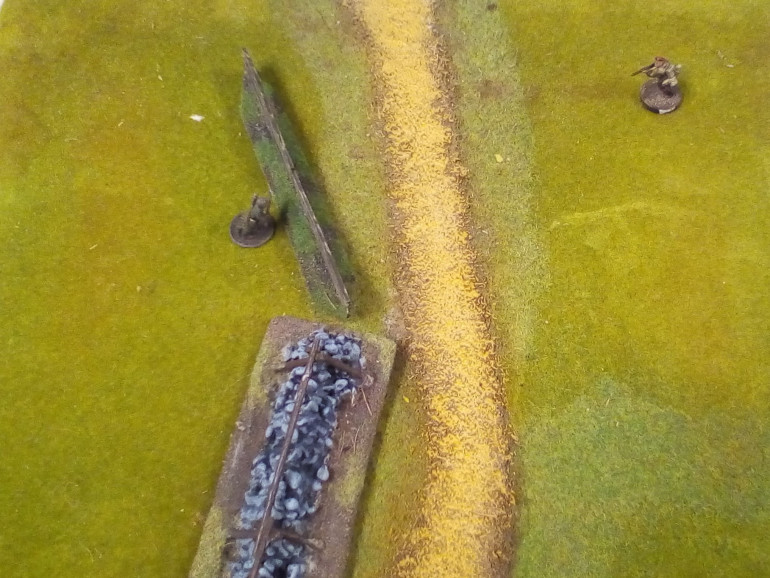 For example a German Soldier behind a wooden fence with a stone wall nearby passes his moral test and so elects to move along the fence to get himself into a better position. If he had failed then he would have had to move behind the stone wall.
For example a German Soldier behind a wooden fence with a stone wall nearby passes his moral test and so elects to move along the fence to get himself into a better position. If he had failed then he would have had to move behind the stone wall. For Example a British Soldier is walking down the middle of a road with two wooden fences to either side. He is shot at by an enemy soldier who is also walking down the centre of the same road, and fails his Cover test. The enemy player can now decide which fence the British soldier takes cover behind since the test was failed.
For Example a British Soldier is walking down the middle of a road with two wooden fences to either side. He is shot at by an enemy soldier who is also walking down the centre of the same road, and fails his Cover test. The enemy player can now decide which fence the British soldier takes cover behind since the test was failed.Why Combat!
What is Combat!
Combat! was a 1960’s TV show set in Normandy in 1944.
It ran for 5 Seasons and had 150+ Episodes mostly in Black and White.
It’s all available for free on YouTube and I’d highly recommend it.
It focused on either Sgt. Saunders or Lt. Henley and almost always had them leading a Squad sized group or smaller trying to either hold a position, blow something up, scout for the enemy, get a wounded man to safety or any other 60’s ear TV Show concept you can imagine.
Why Make a Game?
Because I was very bored and I couldn’t find anything out there that really recreated what I liked.
I’m picky with very small skirmish games, I don’t like a lot of tokens, I don’t like a lot of book keeping and I don’t want it to take forever to play.
So I made my own game that can be played with around 5-10 men in a reasonable amount of time that could work for multiple scenarios.
The Basics
Soldiers are given a name or Number and Activated by a Token. The NCO can swap tokens with any of his squad members. The game uses a D10.
When a soldiers token is drawn they can take an action like running, making a “Combat Move” or firing, if an enemy gives you the opportunity you can forgo an action that turn to take a “Snap Shot” that is far less effective than actually shooting but gives you more tactical flexibility.
When a soldier is hit shot at he has to take a “Cover Check” and if hit something bad will almost always happen, these are bullets after all.
Wounded Men aren’t just removed but play a part in the game. Men with Flesh wounds just can’t run, lightly wounded men can still shoot with a reduced effect but can’t move unless dragged, Seriously Wounded men can’t do anything but the enemy can capture or kill them so protecting a wounded man can become as important as the main objective. Very Seriously Wounded men can die unless helped and even if helped become Seriously wounded.
The game is meant to evolve as you play it, sure your objective is to search that house and return to base but two members of your squad can’t walk so you try to get permission to hold the position and wait for reinforcements which is represented by a die roll that gets modified depending on what shape your force is in.
The Original
The original was a Mess. It was 18 Pages long and had more charts than you can imagine.
The version I’ll be posting here is a much more streamlined version that I hope is a much better game.
Why Combat!
what is Combat!
Combat! was a 1960’s TV show set in Normandy in 1944.
It ran for 5 Seasons and had 150+ Episodes mostly in Black and White.
It’s all available for free on YouTube and I’d highly recommend it.
It focused on either Sgt. Saunders or Lt. Henley and almost always had them leading a Squad sized group or smaller trying to either hold a position, blow something up, scout for the enemy, get a wounded man to safety or any other 60’s ear TV Show concept you can imagine.
Why Make a Game?
Because I was very bored and I couldn’t find anything out there that really recreated what I liked.
I’m picky with very small skirmish games, I don’t like a lot of tokens, I don’t like a lot of book keeping and I don’t want it to take forever to play.
So I made my own game that can be played with around 5-10 men in a reasonable amount of time that could work for multiple scenarios.
The Basics
Soldiers are given a name or Number and Activated by a Token. The NCO can swap tokens with any of his squad members. The game uses a D10.
When a soldiers token is drawn they can take an action like running, making a “Combat Move” or firing, if an enemy gives you the opportunity you can forgo an action that turn to take a “Snap Shot” that is far less effective than actually shooting but gives you more tactical flexibility.
When a soldier is hit shot at he has to take a “Cover Check” and if hit something bad will almost always happen, these are bullets after all.
Wounded Men aren’t just removed but play a part in the game. Men with Flesh wounds just can’t run, lightly wounded men can still shoot with a reduced effect but can’t move unless dragged, Seriously Wounded men can’t do anything but the enemy can capture or kill them so protecting a wounded man can become as important as the main objective. Very Seriously Wounded men can die unless helped and even if helped become Seriously wounded.
The game is meant to evolve as you play it, sure your objective is to search that house and return to base but two members of your squad can’t walk so you try to get permission to hold the position and wait for reinforcements which is represented by a die roll that gets modified depending on what shape your force is in.
The Original
The original was a Mess. It was 18 Pages long and had more charts than you can imagine.
The version I’ll be posting here is a much more streamlined version that I hope is a much better game.









































